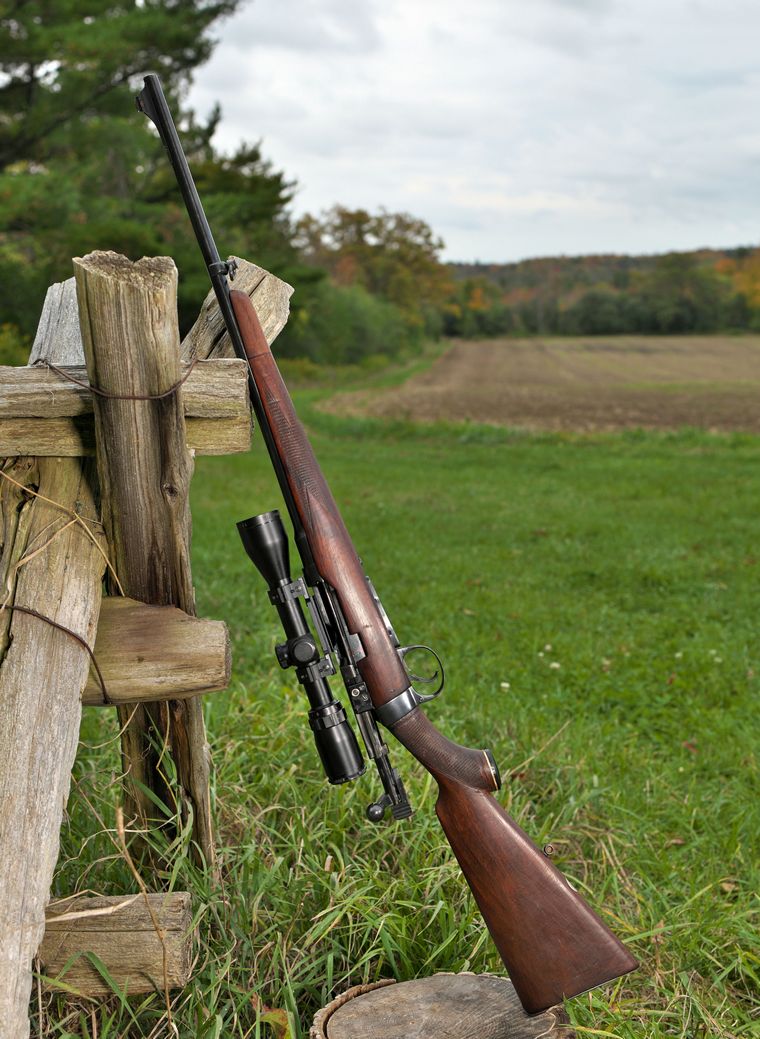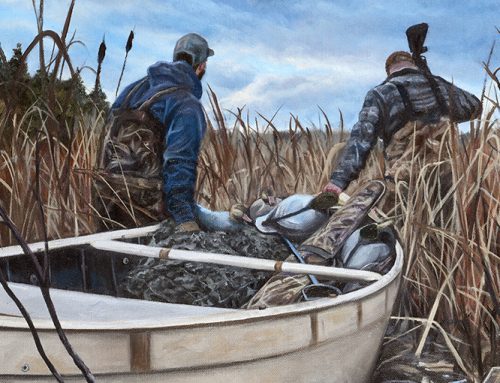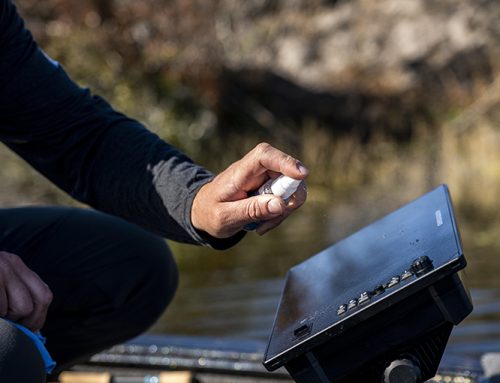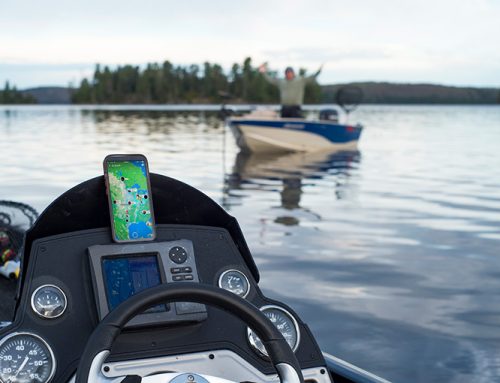
Made: 1895 – c. 1976
Variants: Numerous, mostly .303, also .22, .410 muskets/shotguns,
7.62 x 51 NATO, .303 Epps, .30-06
Production: More than 17 million
Original price: Less than $20 as army surplus
Current value: $400 to $1,000 (original), $150 to $250 (sporterized)
My father-in-law gave me my first moose gun — a bolt-action .303 Lee-Enfield — in 1980. He had purchased it two decades earlier as a surplus First World War relic for $20. He then “sporterized” it under the guidance of renowned gunsmith Ellwood Epps at his Clinton shop. Rugged, reliable, fast, and accurate, my gun epitomizes one of the longest-serving military rifles and a Canadian hunting tradition.
I can’t verify my gun’s history, but, I am confident that it is an early version of the SMLE Mk III*. It has the refined cocking piece and fore-end stock cutouts for the missing charging bridge and magazine cutoff. Regardless of its origins , my father-in-law transformed this Lee-Enfield into a cherished family heirloom.
The Lee-Enfield’s success stems from its ability to evolve to meet military needs and mass-production refinements. Over 17 million rifles were made over nine decades.
James Paris Lee
The Lee-Enfield was designed by James Paris Lee and initially produced in Enfield, England. The Magazine Lee-Enfield (MLE) was introduced in 1895, followed by a Cavalry Carbine in 1896. Both saw action in the Boer War in South Africa, but concerns were raised about poor ballistics.
A shorter, lighter version, the Short Magazine Lee-Enfield (SMLE) was introduced in 1904. Three years later, the SMLE Mk (Mark) III, chambered for the new Mk VII high-velocity Spitzer .303 round was adopted. It featured a 10-shot magazine and a fixed charger guide riveted over the receiver to hold five-round charger clips. It also had a magazine cut-off to fire single rounds.
Wartime use
In 1915, during the First World War, the SMLE Mk III* appeared without the magazine cut-off, without the rear sight windage adjustment, and with a rectangular cocking piece. Both “Smellies” could be fired in the “mad minute” to place 30 rounds into a 12-inch target at 300 yards. In 1926, the SMLE was renamed the No.1 Mk III.
Two iconic models were introduced during the Second World War. The No.4, Mk I (1941) featured an angular charging bridge, receiver-mounted aperture, long-distance ladder sights, and a bolt rail on the inside of the receiver. The Mk I* was only produced at the Long Branch Arsenal in Ontario and by Savage in the United States.
Rifle No.5, Mk I, or “Jungle Carbine,” appeared in 1944 for use by paratroopers and in the Pacific theatre. It had a cut down stock, shorter barrel, and prominent flash hider. Both, plus earlier versions, were also used by Commonwealth troops during the Korean conflict.
Canadian Rangers
The No.4 was also adopted by the Canadian Rangers for patrolling the Arctic from 1947 to 2018. While they used their Lee-Enfields for polar bear protection, many Canadian hunters associate them with moose hunting, especially in Newfoundland. Returning veterans were already familiar with them. Surplus guns and ammunition were cheap and readily available across the country. The .303 Lee-Enfield never really caught on with Americans. Their bolt-action hunting tradition evolved from their .30-06 Springfield Model 1903.
* An asterisk in the rifle name indicates that modifications were made to the rifle to help speed up wartime production.
Ken Doherty is a retired teacher, curator, writer, and a long-time resident of Peterborough. He enjoys collecting, target shooting, and hunting with vintage firearms. Contact Ken at [email protected].
Originally published in the April 2020 edition of Ontario OUT of DOORS magazine.






Re: The .303 LeeEnfield tradition. I have a .303 Parker Hale which I’m sure is based on the Lee Enfield. What is the history of my configuration?
My grandfather (Roy Schauber) did a lot of work with Elwood, mostly the wood work. Jim Butcher did a lot of the metal work. I have a No. 4, Mk 1, Longbranch that Grandpa built, that is the prettiest .303 Ive ever seen. The ring was removed and a rear tang installed so it has a one piece stock. The barrel was shortened and the magazine was cut down so it sits flush. Grandpa didn’t care for ‘scopes so he added a Williams Foolproof aperture sight. That rifle accounted for my first two deer more years ago than I care to admit. I stopped in to see Elwood a few years before he passed and he still had a couple rifles that Grandpa stocked for him. One was an original High Wall chambered in 50-90 that I couldn’t afford, and Elwood wouldn’t budge.
Just out of curiosity, is the 303 not a military style assault rifle? I doubt if our wonderful safety minister Bill Blair would even know that they exist and Turdeau is even further off the mark.I suppose that they are by definition a military style assault weapon,making them illegal to own. Just a thought
My Dad transformed the sites on my Parker Hale Sportster by creating a hood around the front site. Removed and replaced the elevated rear siting assembly. He cut a hacksaw blade in half 1.25 ” in length an turned it with teeth upwards and then brazed it and added an aperture on top that he filed into a 3 tier valley. When raising to shoot… as quickly as the bottom of the valley site came into view within the front hooded site you squeeze off. There was no need for scopes as most shots were within 125 yards. Ammo is the 303 Cal and the ammo used has been 150G wolves/coyotes, 180 G for white tail deer and 200/210G for moose and bear.
Sighting in – was done on a 4″ x 4″ target at 60 yards with placement needed of 4 of 5 shots for accuracy.My 50 years of shooting it have been pleasurable and without mechanical difficulties.
Of Dad and his 3 brothers that volunteered for the Cdn. military in WWII …….Uncle Harold was the one that died during the landing in France. Thanks Dad.
I’ve owned a a half dozen of them, ranging from a flawless custom sporter to extremely crude hack jobs. Oddly enough I sort of favor the hack jobs, since other than the tradition appeal the major bennifits are that they are cheap, and that the factory iron sights are highly usable and nearly impossible to knock out of alignment… once you’ve got them zeroed you never need to waste any rounds checking them. I’ve made a point of killing at least one animal with most of the ones I’ve owned, I was recently given a No4… minus the buttstock and a couple other misc parts… I find few things quite so satisfying as making meat with a free rifle so I’ll likely be packing that No4 around next fall.